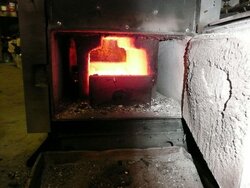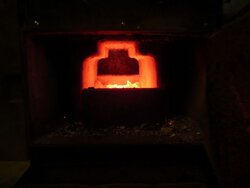Have any members upgraded the Combustion Chamber Bricks in there EKO Boilers. I you have, what changes have you noticed.
EKO Combustion Chamber Upgrade
- Thread starter BulldogAcres
- Start date
-
Active since 1995, Hearth.com is THE place on the internet for free information and advice about wood stoves, pellet stoves and other energy saving equipment.
We strive to provide opinions, articles, discussions and history related to Hearth Products and in a more general sense, energy issues.
We promote the EFFICIENT, RESPONSIBLE, CLEAN and SAFE use of all fuels, whether renewable or fossil.
You are using an out of date browser. It may not display this or other websites correctly.
You should upgrade or use an alternative browser.
You should upgrade or use an alternative browser.
- Status
- Not open for further replies.
mr.fixit
Feeling the Heat
Yeah I got the new style lower blocks.I like them. Its alot easier to clean the ashes out,and it seems like the flame has more room to swirl so I do think they are an improvement.BulldogAcres said:Have any members upgraded the Combustion Chamber Bricks in there EKO Boilers. I you have, what changes have you noticed.
mr.fixit
Feeling the Heat
pybyr
Minister of Fire
Nofossil did some experiments on a number of different layouts of lower refractories in an EKO 25 (I think around 2008) - try the search function to see if you can pull it up.
Nofossil
Moderator Emeritus
This thread covers some of my attempts. As with many things about gasifiers (and life in general), there's more to it than meets the eye.
Hunderliggur
Minister of Fire
Mr. Fixit - interesting design compared to the U blocks. Do they work any better? Easier to gassify? More heat output? Inquiring minds want to know.
mr.fixit
Feeling the Heat
They are an improvement over the u-shaped blocks. The big thing I like obout them is ash removal is alot easier plus a little more room for ashes.As far as gasifing performance they work about the same-maybe just alittle better because they leave more room for the flame.
It looks like they are cast with the stainless-steel needles in so they may hold together longer.
My old blocks both cracked into 3 pieces midway through the first season,I think being cherry red 90% of the time had something to do with it!
They did cover replacement under warranty after 2 or 3 calls but I had to pay the extra cost of the new style upgrade.
It looks like they are cast with the stainless-steel needles in so they may hold together longer.
My old blocks both cracked into 3 pieces midway through the first season,I think being cherry red 90% of the time had something to do with it!
They did cover replacement under warranty after 2 or 3 calls but I had to pay the extra cost of the new style upgrade.
sdrobertson
Minister of Fire
nofossil said:This thread covers some of my attempts. As with many things about gasifiers (and life in general), there's more to it than meets the eye.
What did you end up using? I remember this old post, but I can't recall what you ended up with.
Nofossil
Moderator Emeritus
sdrobertson said:nofossil said:This thread covers some of my attempts. As with many things about gasifiers (and life in general), there's more to it than meets the eye.
What did you end up using? I remember this old post, but I can't recall what you ended up with.
I'm currently using a simple labyrinth made of 3000 degree high-alumina splits. It's essentially two top-to-bottom walls that go from the back to about 6" short of the front. I'll try and get a photo.
Nofossil
Moderator Emeritus
Cave2k said:There are some places advertising castable refractory rated to 300 degrees now. Worth the effort?
300 degrees? I'll just try plywood ;-)
Seriously, this is a topic of major interest for me. My brother cast the floor of his gasifier and had it baked in a kiln. It cracked in the first season. It's not ruined, and he's still using it, but I think that the temperature gradients in gasifiers create thermal stress that requires more than just a high temperature rating.
I'm eagerly awaiting any test data from anyone who tries this.
Fred61
Minister of Fire
nofossil said:Cave2k said:There are some places advertising castable refractory rated to 300 degrees now. Worth the effort?
300 degrees? I'll just try plywood ;-)
Seriously, this is a topic of major interest for me. My brother cast the floor of his gasifier and had it baked in a kiln. It cracked in the first season. It's not ruined, and he's still using it, but I think that the temperature gradients in gasifiers create thermal stress that requires more than just a high temperature rating.
I'm eagerly awaiting any test data from anyone who tries this.
The floor in my 25 is in three sections. I'm sure that was done to relieve stress.
Anybody out there tried simply putting a thin piece of refractory (like a tile) down where the flame jet hits the floor to take the brunt of the heat. Rather than finding a material that will hold up to the heat in a thick section, just a disposable liner that gets tossed every season or something? The gradient across a thin section might not be so stressful.
In my mind's eye is the sight inside of a porcelain kiln with a roaring gas flame hitting the bottom of the lowest kiln shelf and spreading out to the rest of the interior. I think those were silicon carbide but that was back 4 decades ago.
Got any old porcelain plates in a box somewhere?
In my mind's eye is the sight inside of a porcelain kiln with a roaring gas flame hitting the bottom of the lowest kiln shelf and spreading out to the rest of the interior. I think those were silicon carbide but that was back 4 decades ago.
Got any old porcelain plates in a box somewhere?
Nofossil
Moderator Emeritus
DaveBP said:Anybody out there tried simply putting a thin piece of refractory (like a tile) down where the flame jet hits the floor to take the brunt of the heat. Rather than finding a material that will hold up to the heat in a thick section, just a disposable liner that gets tossed every season or something? The gradient across a thin section might not be so stressful.
In my mind's eye is the sight inside of a porcelain kiln with a roaring gas flame hitting the bottom of the lowest kiln shelf and spreading out to the rest of the interior. I think those were silicon carbide but that was back 4 decades ago.
Got any old porcelain plates in a box somewhere?
Porcelain tile becomes gravel in a week or so. 2300 degree firebrick takes a month. Titanium sheet takes a day. 3/4" plate steel erodes away in a month or so. It's a nasty environment. I had some success throwing in glass. It melts to liquid, then gets mixed with cinders. Not pretty, but it doesn't erode much. I've used a layer of that over conventional firebrick. Lasts a couple of months.
barnartist
Minister of Fire
I have begun to notice decay of the bottom of my nozzles. I am wondering how I will fix them when the time comes.
I am still using the old U's this is my 5th season. It does appear they will break up soon as there are visible cracks.
I am still using the old U's this is my 5th season. It does appear they will break up soon as there are visible cracks.
tom in maine
Minister of Fire
I have destroyed many types of refractory in our small prototype boilers. It seems wise to only be considering 3,000F firebrick. I suspect one very big issue is to make sure that any firebrick or refractory is thoroughly dried before ever firing. I used some 1 1/4" firebricks that came right from the brickyard (outdoors). They warped like a piece of wood. (Note to self--try not to be this stupid again!)
The stress relief that firebrick affords a combustion chamber is worth looking very seriously at. The relatively low cost is also a significant factor.
The stress relief that firebrick affords a combustion chamber is worth looking very seriously at. The relatively low cost is also a significant factor.
VeggieFarmer
New Member
barnartist said:I have begun to notice decay of the bottom of my nozzles. I am wondering how I will fix them when the time comes.
I am also seeing similar degradation in the nozzle, mid-way through my third season. Instead of being rectangular, the two ends of the groove are flaring out such that the nozzle now looks like a dumbbell, with the fat ends being nearly twice the width of the original groove. Anyone else seeing this? Anyone attempted a replacement?
nofossil said:Cave2k said:There are some places advertising castable refractory rated to 300 degrees now. Worth the effort?
300 degrees? I'll just try plywood ;-)
Seriously, this is a topic of major interest for me. My brother cast the floor of his gasifier and had it baked in a kiln. It cracked in the first season. It's not ruined, and he's still using it, but I think that the temperature gradients in gasifiers create thermal stress that requires more than just a high temperature rating.
I'm eagerly awaiting any test data from anyone who tries this.
Just saw the typo. Ho ho ho that's a rip. Good catch. I do suggest you don't use plywood though as the glue probably won't hold up. Just $.02 :red:
VeggieFarmer said:barnartist said:I have begun to notice decay of the bottom of my nozzles. I am wondering how I will fix them when the time comes.
I am also seeing similar degradation in the nozzle, mid-way through my third season. Instead of being rectangular, the two ends of the groove are flaring out such that the nozzle now looks like a dumbbell, with the fat ends being nearly twice the width of the original groove. Anyone else seeing this? Anyone attempted a replacement?
Perhaps I am errant in my thinking but IF I recall correctly Orlan makes replacement nozzle pieces available. In some degree they should be warrantable for the oem.
- Status
- Not open for further replies.
Similar threads
- Replies
- 3
- Views
- 544
- Replies
- 2
- Views
- 849
- Replies
- 1
- Views
- 357
- Replies
- 3
- Views
- 569



